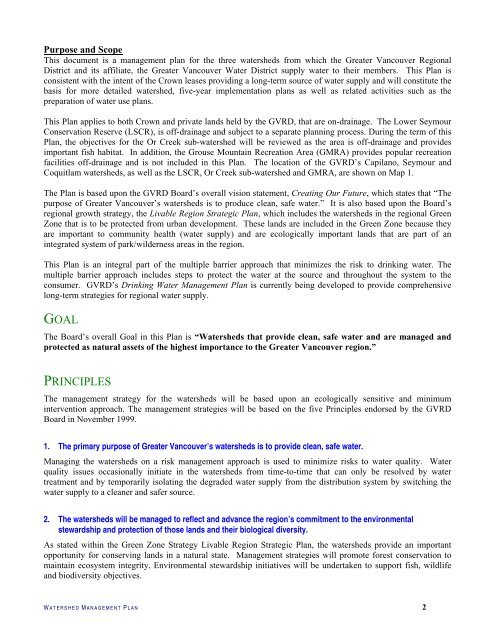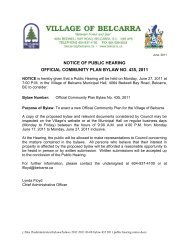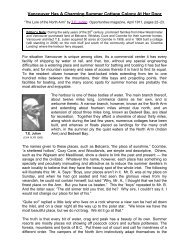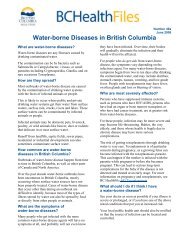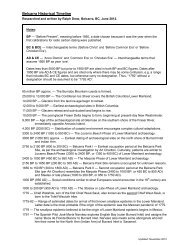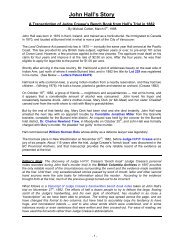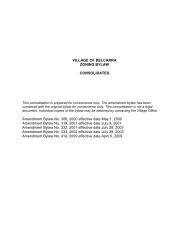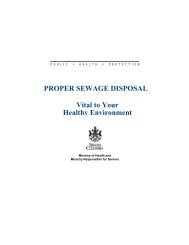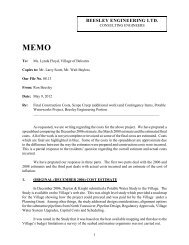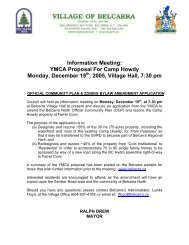Metro Vancouver's Watershed Management Plan
Metro Vancouver's Watershed Management Plan
Metro Vancouver's Watershed Management Plan
You also want an ePaper? Increase the reach of your titles
YUMPU automatically turns print PDFs into web optimized ePapers that Google loves.
Purpose and Scope<br />
This document is a management plan for the three watersheds from which the Greater Vancouver Regional<br />
District and its affiliate, the Greater Vancouver Water District supply water to their members. This <strong>Plan</strong> is<br />
consistent with the intent of the Crown leases providing a long-term source of water supply and will constitute the<br />
basis for more detailed watershed, five-year implementation plans as well as related activities such as the<br />
preparation of water use plans.<br />
This <strong>Plan</strong> applies to both Crown and private lands held by the GVRD, that are on-drainage. The Lower Seymour<br />
Conservation Reserve (LSCR), is off-drainage and subject to a separate planning process. During the term of this<br />
<strong>Plan</strong>, the objectives for the Or Creek sub-watershed will be reviewed as the area is off-drainage and provides<br />
important fish habitat. In addition, the Grouse Mountain Recreation Area (GMRA) provides popular recreation<br />
facilities off-drainage and is not included in this <strong>Plan</strong>. The location of the GVRD’s Capilano, Seymour and<br />
Coquitlam watersheds, as well as the LSCR, Or Creek sub-watershed and GMRA, are shown on Map 1.<br />
The <strong>Plan</strong> is based upon the GVRD Board’s overall vision statement, Creating Our Future, which states that “The<br />
purpose of Greater Vancouver’s watersheds is to produce clean, safe water.” It is also based upon the Board’s<br />
regional growth strategy, the Livable Region Strategic <strong>Plan</strong>, which includes the watersheds in the regional Green<br />
Zone that is to be protected from urban development. These lands are included in the Green Zone because they<br />
are important to community health (water supply) and are ecologically important lands that are part of an<br />
integrated system of park/wilderness areas in the region.<br />
This <strong>Plan</strong> is an integral part of the multiple barrier approach that minimizes the risk to drinking water. The<br />
multiple barrier approach includes steps to protect the water at the source and throughout the system to the<br />
consumer. GVRD’s Drinking Water <strong>Management</strong> <strong>Plan</strong> is currently being developed to provide comprehensive<br />
long-term strategies for regional water supply.<br />
GOAL<br />
The Board’s overall Goal in this <strong>Plan</strong> is “<strong>Watershed</strong>s that provide clean, safe water and are managed and<br />
protected as natural assets of the highest importance to the Greater Vancouver region.”<br />
PRINCIPLES<br />
The management strategy for the watersheds will be based upon an ecologically sensitive and minimum<br />
intervention approach. The management strategies will be based on the five Principles endorsed by the GVRD<br />
Board in November 1999.<br />
1. The primary purpose of Greater Vancouver’s watersheds is to provide clean, safe water.<br />
Managing the watersheds on a risk management approach is used to minimize risks to water quality. Water<br />
quality issues occasionally initiate in the watersheds from time-to-time that can only be resolved by water<br />
treatment and by temporarily isolating the degraded water supply from the distribution system by switching the<br />
water supply to a cleaner and safer source.<br />
2. The watersheds will be managed to reflect and advance the region’s commitment to the environmental<br />
stewardship and protection of those lands and their biological diversity.<br />
As stated within the Green Zone Strategy Livable Region Strategic <strong>Plan</strong>, the watersheds provide an important<br />
opportunity for conserving lands in a natural state. <strong>Management</strong> strategies will promote forest conservation to<br />
maintain ecosystem integrity. Environmental stewardship initiatives will be undertaken to support fish, wildlife<br />
and biodiversity objectives.<br />
W ATERSHED M ANAGEMENT P LAN 2


